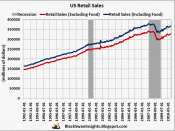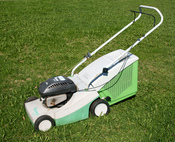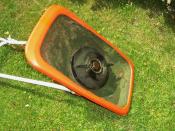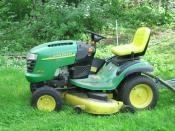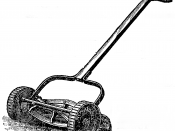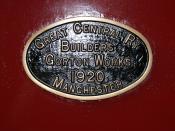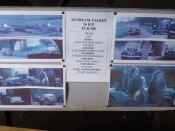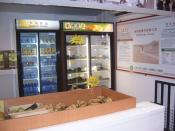Sales of Garden Retail The money profit in the garden department inside a retail store has ups and downs just like every other company. Some weeks the sales are high, other weeks the sales are barely breaking even. The need to determine what product sales the best at what time and what needs to be forced to sell other times. The garden season really starts to begin at the end of April and continues to make sales through out the season. The garden center starts to lose sales at the end of July. The reason for the decrease in sales is due to the time the flowers should be planted and most plants and flowers need to be planted before the hot horrible weather hits, the beginning of the summer.
Through out this project I will talk about margin of sale, the quantity of sale and I will also calculate the money loss through this department alone.
The garden is not only the flowers and plants you do yourself but also the landscaping and the ceramic pots, lawnmowers, bird feed and anything relating to the outside area of your home or project you might be working on at the time.
The garden center is one of our largest departments in the company and makes the most money for the company during the peak seasons. I will also compare the sales from last year to this year's and give a reason why they might have been higher or lower. The sales in this store are divided into thirteen periods and the periods are all four weeks. The periods I did my research on were the period four and period five. That's when sales have the highest ups and downs.
In the chart I have talked about the garden center and floral department sales from last year and this year in comparison to the budget and margin. How much money we have made as a company after the margin, and what our operational income is exactly. Each year and week is different so I have only charted period five out of the thirteen periods.
The period five overview runs like this Garden Center Budget TY LY Sales 83,993 76,039 98,797 Margin 30,838 25,341 37,686 Operation Income -------- -1,812 4, 550 Floral Depart. Budget TY LY Sales 121,956 119,841 171,901 Margin 39,102 34,347 53,334 Operation Income --------- 12,631 25,532 Sales: Classes with the greatest opportunity compared to last year 8014 live plants -37% 8015 garden chemicals -33% 8062 garden tools -32% Cause: Outdoor live goods had huge increases during periods three and four. Due to the great early season, sales have slowed earlier than normal. This makes the tie-in sales from the class 8062 very difficult. The weather also hinders 8015 sales, as it is too hot to use much of the product from that class.
Action: As the peak-selling season for the garden fades, the company can concentrate on being in stock on the product the customers are looking for. The company will work on making and maintaining the best outdoor displays in the business. The company will strive for perfect customer service, and will work for the tie-in sales in every way possible.
Result: The company will maintain strong sales as the season fades, allowing sales to better reflect the potential of the department.
Margin: Divisions with the greatest opportunity as compared to budget GCR -18% FLR -12% Cause: Earlier efforts have been made in the FLR to sell plants before they become a write off. This has causes period five markdowns to increase in class 8014. ADS (what items are on sale that week) and TPRS (TPR is temporary price reduction) have been a big factor for GCR, as Fred Meyer brand, and other products are being discontinued.
Action: The company needs to keep a sharp appearance in the garden center. ERB (Early Recovery Breakdown) is a huge part of their margin. They will increase plant care time to help reduce markdowns and write-offs.
Result: The plant presentation will be better so markdowns and write-offs will be lower increasing margin in FLR. They have much less DI's (discontinued merchandise) so the margin in the GCR will be stronger.
Operational Income: GCR -1,812 FLR 12,631 Cause: The FLR business is still very profitable. The GCR lost money due to the lack of sales.
Action: They need to maximize sales in FLR, by having the best selection and quality available. Trying to up-sell in the GCR as much as possible.
The identification Gross Margin is the money the company gets not including what the company pays for the product. For example the company takes the gross margin and takes away from the wages, shrink, money to pay the main office, bills, etc., they take a little money from each department depending on how much money each department makes. If one department does better the another department then a smaller amount comes from the department that didn't make as high of sales or barely met.
The sales the company takes in to the department is the total of items scanned and the amount they all equal to and the end of the day. For example if the garden center only sold one lawn mower all day and that lawn mower was $340.00 and last year their sales were far above that then they are down on sales for that day. If they are down one day they have to try and make up for it the other days of the week. (The week of sales runs from Sunday to Saturday) The margin for the company is the money paid to the company after paying the suppliers for the product. So another example if the garden center had sales of $83,993 after paying all the suppliers then and the list I mentioned before the company would only make $30,838.
Operational Income is the bottom line. It's how much the company gets after they pay for salary, taxes, work comp, and to the regional office. So they can be down some days because of all the money they have to pay out to different parts of the company.
An example from the operational income is garden carts. Garden Carts are larger carts that come out of the operational income because it is something the store doesn't need but the manager thinks is beneficial for the company to have. The bigger the cart the more merchandise you can put on it. Each cart is $825.00 and the garden center was approved to buy three. If the operational income is down for that period then it will be taken out of other departments through out the company so they will be paid for eventually depending on the how high or low the garden center operational income is.
Markdowns, shrink (or theft), write-offs, salvage, ERB, are all close to the same thing. They are all areas that make a company lose money due to the list above. Markdowns are plants, flowers or something that is not a big seller. By marking it down after it has been on AD or TPR (Temporary Price Reduction) then the manager makes a decision to mark it down. The manager decides the total value of the product then marks down considering how low to keep margin. If it's not a good mark down it will never sell and the company still loses money in the end. Better to have some money than no money at all.
Shrink is stolen merchandise that can't be accounted for when inventory comes and the company still gets billed for the missing merchandise. Another example is say a supplier delivers 1,000 plants and the person in the garden center at that time decides that he is just going to sign for it before counting the merchandise coming off the truck. The department still gets charged for the full 1,000 plants that's called shrink.
Salvage, write-offs and ERB and close to the same thing. It is when a product comes back to the store because a customer was not happy with the merchandise they picked up. The company either writes it off and we will get money for that depending on the reason for the returned merchandise. Salvage would be for an example a plant that has bugs that eat the entire plant. The company can give money back to that customer because it was our supplier's fault and we lose the money. ERB is something that has not gone on AD or TPR yet but has a broken branch or something. The manager then can mark down that product or item and try to get money but not the full amount.
The major reason to keep money in is for people to have jobs and to help the public receive the best quality of merchandise that this company can give to them. In stock merchandising is the best way to keep the public coming back. Making sure you have not only in stock products but excellent in stock product.
The graph is a comparison from last year sales to this year sales, and the increase or decrease as a company total in that department. The following chart will hopefully help.
July 15 July 16 July 17 July 18 July 19 July 20 July 21 TY 1334 1992 1667 833 1025 910 1944 LY 1635 1248 1495 1376 1279 1454 2194 -18.4% 59.5% 11.5% -39.4% -19.8% -37.4% -11.3% Garden Center was down in sales -9.1% as compared to last year sales, on the same days.
Sales of Garden Retail The money profit in the garden department inside a retail store has ups and downs just like every other company. Some weeks the sales are high, other weeks the sales are barely breaking even. The need to determine what product sales the best at what time and what needs to be forced to sell other times. The garden season really starts to begin at the end of April and continues to make sales through out the season. The garden center starts to lose sales at the end of July. The reason for the decrease in sales is due to the time the flowers should be planted and most plants and flowers need to be planted before the hot horrible weather hits, the beginning of the summer.
Through out this project I will talk about margin of sale, the quantity of sale and I will also calculate the money loss through this department alone. The garden is not only the flowers and plants you do yourself but also the landscaping and the ceramic pots, lawnmowers, bird feed and anything relating to the outside area of your home or project you might be working on at the time.
The garden center is one of our largest departments in the company and makes the most money for the company during the peak seasons. I will also compare the sales from last year to this year's and give a reason why they might have been higher or lower. The sales in this store are divided into thirteen periods and the periods are all four weeks. The periods I did my research on were the period four and period five. That's when sales have the highest ups and downs.
In the chart I have talked about the garden center and floral department sales from last year and this year in comparison to the budget and margin. How much money we have made as a company after the margin, and what our operational income is exactly. Each year and week is different so I have only charted period five out of the thirteen periods.
The period five overview runs like this Garden Center Budget TY LY Sales 83,993 76,039 98,797 Margin 30,838 25,341 37,686 Operation Income -------- -1,812 4, 550 Floral Depart. Budget TY LY Sales 121,956 119,841 171,901 Margin 39,102 34,347 53,334 Operation Income --------- 12,631 25,532 Sales: Classes with the greatest opportunity compared to last year 8014 live plants -37% 8015 garden chemicals -33% 8062 garden tools -32% Cause: Outdoor live goods had huge increases during periods three and four. Due to the great early season, sales have slowed earlier than normal. This makes the tie-in sales from the class 8062 very difficult. The weather also hinders 8015 sales, as it is too hot to use much of the product from that class.
Action: As the peak-selling season for the garden fades, the company can concentrate on being in stock on the product the customers are looking for. The company will work on making and maintaining the best outdoor displays in the business. The company will strive for perfect customer service, and will work for the tie-in sales in every way possible.
Result: The company will maintain strong sales as the season fades, allowing sales to better reflect the potential of the department.
Margin: Divisions with the greatest opportunity as compared to budget GCR -18% FLR -12% Cause: Earlier efforts have been made in the FLR to sell plants before they become a write off. This has causes period five markdowns to increase in class 8014. ADS (what items are on sale that week) and TPRS (TPR is temporary price reduction) have been a big factor for GCR, as Fred Meyer brand, and other products are being discontinued.
Action: The company needs to keep a sharp appearance in the garden center. ERB (Early Recovery Breakdown) is a huge part of their margin. They will increase plant care time to help reduce markdowns and write-offs.
Result: The plant presentation will be better so markdowns and write-offs will be lower increasing margin in FLR. They have much less DI's (discontinued merchandise) so the margin in the GCR will be stronger.
Operational Income: GCR -1,812 FLR 12,631 Cause: The FLR business is still very profitable. The GCR lost money due to the lack of sales.
Action: They need to maximize sales in FLR, by having the best selection and quality available. Trying to up-sell in the GCR as much as possible.
The identification Gross Margin is the money the company gets not including what the company pays for the product. For example the company takes the gross margin and takes away from the wages, shrink, money to pay the main office, bills, etc., they take a little money from each department depending on how much money each department makes. If one department does better the another department then a smaller amount comes from the department that didn't make as high of sales or barely met.
The sales the company takes in to the department is the total of items scanned and the amount they all equal to and the end of the day. For example if the garden center only sold one lawn mower all day and that lawn mower was $340.00 and last year their sales were far above that then they are down on sales for that day. If they are down one day they have to try and make up for it the other days of the week. (The week of sales runs from Sunday to Saturday) The margin for the company is the money paid to the company after paying the suppliers for the product. So another example if the garden center had sales of $83,993 after paying all the suppliers then and the list I mentioned before the company would only make $30,838.
Operational Income is the bottom line. It's how much the company gets after they pay for salary, taxes, work comp, and to the regional office. So they can be down some days because of all the money they have to pay out to different parts of the company.
An example from the operational income is garden carts. Garden Carts are larger carts that come out of the operational income because it is something the store doesn't need but the manager thinks is beneficial for the company to have. The bigger the cart the more merchandise you can put on it. Each cart is $825.00 and the garden center was approved to buy three. If the operational income is down for that period then it will be taken out of other departments through out the company so they will be paid for eventually depending on the how high or low the garden center operational income is.
Markdowns, shrink (or theft), write-offs, salvage, ERB, are all close to the same thing. They are all areas that make a company lose money due to the list above. Markdowns are plants, flowers or something that is not a big seller. By marking it down after it has been on AD or TPR (Temporary Price Reduction) then the manager makes a decision to mark it down. The manager decides the total value of the product then marks down considering how low to keep margin. If it's not a good mark down it will never sell and the company still loses money in the end. Better to have some money than no money at all.
Shrink is stolen merchandise that can't be accounted for when inventory comes and the company still gets billed for the missing merchandise. Another example is say a supplier delivers 1,000 plants and the person in the garden center at that time decides that he is just going to sign for it before counting the merchandise coming off the truck. The department still gets charged for the full 1,000 plants that's called shrink.
Salvage, write-offs and ERB and close to the same thing. It is when a product comes back to the store because a customer was not happy with the merchandise they picked up. The company either writes it off and we will get money for that depending on the reason for the returned merchandise. Salvage would be for an example a plant that has bugs that eat the entire plant. The company can give money back to that customer because it was our supplier's fault and we lose the money. ERB is something that has not gone on AD or TPR yet but has a broken branch or something. The manager then can mark down that product or item and try to get money but not the full amount.
The major reason to keep money in is for people to have jobs and to help the public receive the best quality of merchandise that this company can give to them. In stock merchandising is the best way to keep the public coming back. Making sure you have not only in stock products but excellent in stock product.
The graph is a comparison from last year sales to this year sales, and the increase or decrease as a company total in that department. The following chart will hopefully help.
July 15 July 16 July 17 July 18 July 19 July 20 July 21 TY 1334 1992 1667 833 1025 910 1944 LY 1635 1248 1495 1376 1279 1454 2194 -18.4% 59.5% 11.5% -39.4% -19.8% -37.4% -11.3% Garden Center was down in sales -9.1% as compared to last year sales, on the same days.
Sales of Garden Retail The money profit in the garden department inside a retail store has ups and downs just like every other company. Some weeks the sales are high, other weeks the sales are barely breaking even. The need to determine what product sales the best at what time and what needs to be forced to sell other times. The garden season really starts to begin at the end of April and continues to make sales through out the season. The garden center starts to lose sales at the end of July. The reason for the decrease in sales is due to the time the flowers should be planted and most plants and flowers need to be planted before the hot horrible weather hits, the beginning of the summer.
Through out this project I will talk about margin of sale, the quantity of sale and I will also calculate the money loss through this department alone. The garden is not only the flowers and plants you do yourself but also the landscaping and the ceramic pots, lawnmowers, bird feed and anything relating to the outside area of your home or project you might be working on at the time.
The garden center is one of our largest departments in the company and makes the most money for the company during the peak seasons. I will also compare the sales from last year to this year's and give a reason why they might have been higher or lower. The sales in this store are divided into thirteen periods and the periods are all four weeks. The periods I did my research on were the period four and period five. That's when sales have the highest ups and downs.
In the chart I have talked about the garden center and floral department sales from last year and this year in comparison to the budget and margin. How much money we have made as a company after the margin, and what our operational income is exactly. Each year and week is different so I have only charted period five out of the thirteen periods.
The period five overview runs like this Garden Center Budget TY LY Sales 83,993 76,039 98,797 Margin 30,838 25,341 37,686 Operation Income -------- -1,812 4, 550 Floral Depart. Budget TY LY Sales 121,956 119,841 171,901 Margin 39,102 34,347 53,334 Operation Income --------- 12,631 25,532 Sales: Classes with the greatest opportunity compared to last year 8014 live plants -37% 8015 garden chemicals -33% 8062 garden tools -32% Cause: Outdoor live goods had huge increases during periods three and four. Due to the great early season, sales have slowed earlier than normal. This makes the tie-in sales from the class 8062 very difficult. The weather also hinders 8015 sales, as it is too hot to use much of the product from that class.
Action: As the peak-selling season for the garden fades, the company can concentrate on being in stock on the product the customers are looking for. The company will work on making and maintaining the best outdoor displays in the business. The company will strive for perfect customer service, and will work for the tie-in sales in every way possible.
Result: The company will maintain strong sales as the season fades, allowing sales to better reflect the potential of the department.
Margin: Divisions with the greatest opportunity as compared to budget GCR -18% FLR -12% Cause: Earlier efforts have been made in the FLR to sell plants before they become a write off. This has causes period five markdowns to increase in class 8014. ADS (what items are on sale that week) and TPRS (TPR is temporary price reduction) have been a big factor for GCR, as Fred Meyer brand, and other products are being discontinued.
Action: The company needs to keep a sharp appearance in the garden center. ERB (Early Recovery Breakdown) is a huge part of their margin. They will increase plant care time to help reduce markdowns and write-offs.
Result: The plant presentation will be better so markdowns and write-offs will be lower increasing margin in FLR. They have much less DI's (discontinued merchandise) so the margin in the GCR will be stronger.
Operational Income: GCR -1,812 FLR 12,631 Cause: The FLR business is still very profitable. The GCR lost money due to the lack of sales.
Action: They need to maximize sales in FLR, by having the best selection and quality available. Trying to up-sell in the GCR as much as possible.
The identification Gross Margin is the money the company gets not including what the company pays for the product. For example the company takes the gross margin and takes away from the wages, shrink, money to pay the main office, bills, etc., they take a little money from each department depending on how much money each department makes. If one department does better the another department then a smaller amount comes from the department that didn't make as high of sales or barely met.
The sales the company takes in to the department is the total of items scanned and the amount they all equal to and the end of the day. For example if the garden center only sold one lawn mower all day and that lawn mower was $340.00 and last year their sales were far above that then they are down on sales for that day. If they are down one day they have to try and make up for it the other days of the week. (The week of sales runs from Sunday to Saturday) The margin for the company is the money paid to the company after paying the suppliers for the product. So another example if the garden center had sales of $83,993 after paying all the suppliers then and the list I mentioned before the company would only make $30,838.
Operational Income is the bottom line. It's how much the company gets after they pay for salary, taxes, work comp, and to the regional office. So they can be down some days because of all the money they have to pay out to different parts of the company.
An example from the operational income is garden carts. Garden Carts are larger carts that come out of the operational income because it is something the store doesn't need but the manager thinks is beneficial for the company to have. The bigger the cart the more merchandise you can put on it. Each cart is $825.00 and the garden center was approved to buy three. If the operational income is down for that period then it will be taken out of other departments through out the company so they will be paid for eventually depending on the how high or low the garden center operational income is.
Markdowns, shrink (or theft), write-offs, salvage, ERB, are all close to the same thing. They are all areas that make a company lose money due to the list above. Markdowns are plants, flowers or something that is not a big seller. By marking it down after it has been on AD or TPR (Temporary Price Reduction) then the manager makes a decision to mark it down. The manager decides the total value of the product then marks down considering how low to keep margin. If it's not a good mark down it will never sell and the company still loses money in the end. Better to have some money than no money at all.
Shrink is stolen merchandise that can't be accounted for when inventory comes and the company still gets billed for the missing merchandise. Another example is say a supplier delivers 1,000 plants and the person in the garden center at that time decides that he is just going to sign for it before counting the merchandise coming off the truck. The department still gets charged for the full 1,000 plants that's called shrink.
Salvage, write-offs and ERB and close to the same thing. It is when a product comes back to the store because a customer was not happy with the merchandise they picked up. The company either writes it off and we will get money for that depending on the reason for the returned merchandise. Salvage would be for an example a plant that has bugs that eat the entire plant. The company can give money back to that customer because it was our supplier's fault and we lose the money. ERB is something that has not gone on AD or TPR yet but has a broken branch or something. The manager then can mark down that product or item and try to get money but not the full amount.
The major reason to keep money in is for people to have jobs and to help the public receive the best quality of merchandise that this company can give to them. In stock merchandising is the best way to keep the public coming back. Making sure you have not only in stock products but excellent in stock product.
The graph is a comparison from last year sales to this year sales, and the increase or decrease as a company total in that department. The following chart will hopefully help.
July 15 July 16 July 17 July 18 July 19 July 20 July 21 TY 1334 199
